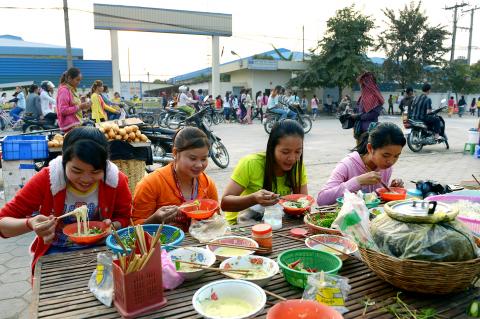As night falls in Phonm Penh, thousands of weary workers stream from textile factories, reflecting the abundance of jobs created by the clothing industry’s desire for cheap labor.
However, as the number of international clothes companies tapping into Cambodia’s workforce grows, so does anger at the low wages and tough conditions that come with such employment in the global garment industry.
Twenty-five-year-old Ou Nin looks exhausted as she describes working for a US clothes brand for just above US$5 a day.

Photo: AFP
“They print on T-shirts. The smell is very unpleasant, it is unbearable,” she said while waiting for the truck to take her home.
Overwork, malnutrition and poor ventilation are to blame for staff fainting in factories since 2010, said Moeun Tola, program manager at the Community Legal Education Centre, which provides advocacy for workers.
“It’s often hot inside these factories. Sometimes they inhale toxic substances,” he said, adding that last year, 1,100 workers are known to have lost consciousness at work while a further 30 fainted in a workshop in mid-January.
With bonuses and overtime, workers can earn an average of US$110 a month — a low salary given Cambodia’s cost of living — forcing many to work beyond the legal limit of 60 hours a week.
A series of strikes point to festering discontent — leaving the big global clothes brands and the factories they subcontract to trade accusations over who is driving salaries down.
Protests by workers have also turned ugly. Three women, employees of Puma supplier Kaoway Sports, were wounded when a gunman opened fire on protesters demanding better working conditions at factories in eastern Svay Rieng Province in February last year.
The shooting prompted Puma, Gap and H&M to express their “deep concern” and urge a thorough investigation.
However, discontent lingers on the factory floor where 400,000 of the 650,000 people employed in the industry work for foreign firms.
Soey Eao, who has worked in the industry for five years, lives in a dormitory behind her factory, paying nearly US$20 a month to share a room with three colleagues.
Hundreds of workers co-exist in similar spartan concrete lodgings, without water or electricity.
“With overtime, I can reach US$78 a month. I work 12 hours a day, sometimes seven days in a row to earn more,” Soey Eao said, adding that she sends one-third of her salary to her family. “I’ve already protested for a raise. I cannot even eat well because I’m trying to put money aside, I just buy the minimum to survive.”
Soey Eao is hopefulthat her situation may change with her union pushing to boost the minimum wage from the US$60 a month to about US$100.
Yet while strikes have turned up the heat on factory owners and international brands, she said that many workers still “do not even know they have rights.”
The International Labour Office, which regularly inspects textile mills in the country, has called for a new industrial agreement between the government, factory owners and unions.
“Clearly there is some room for additional payment,” the group’s Jill Tucker said, adding that after Bangladesh, Cambodia is one of the cheapest places to make garments.
Cambodia’s factory owners say the problem is not their fault and blame the profit margins of foreign brands for driving down wages.
“If our wages were comparable to Vietnam, would investors come to Cambodia? No way,” said Ken Loo, secretary-general of the Garment Manufacturers Association in Cambodia.
“They [buyers] are the ones who set the margin, not us,” he said, warning that if Cambodia raises the minimum wage it would “have to be prepared for what comes after,” hinting that companies may choose to relocate.
However, several big brands contacted by media denied they were cutting wages.
Swedish fashion giant H&M, which in October last year was forced to deny accusations that it encouraged “slave-like” wages at a subcontractor’s factory, said it was not directly responsible for the factories producing its garments.
“H&M does not own any factories and therefore does not set or pay factory workers’ wages,” company spokesman Malin Bjorne said, adding that Cambodian factories produce for many brands.
“The employees at a factory are paid the same wages regardless of which brand they are producing garments for — and regardless of what the final price will be in the store,” Bjorne said.

Taiwan Semiconductor Manufacturing Co (TSMC, 台積電) last week recorded an increase in the number of shareholders to the highest in almost eight months, despite its share price falling 3.38 percent from the previous week, Taiwan Stock Exchange data released on Saturday showed. As of Friday, TSMC had 1.88 million shareholders, the most since the week of April 25 and an increase of 31,870 from the previous week, the data showed. The number of shareholders jumped despite a drop of NT$50 (US$1.59), or 3.38 percent, in TSMC’s share price from a week earlier to NT$1,430, as investors took profits from their earlier gains

AI TALENT: No financial details were released about the deal, in which top Groq executives, including its CEO, would join Nvidia to help advance the technology Nvidia Corp has agreed to a licensing deal with artificial intelligence (AI) start-up Groq, furthering its investments in companies connected to the AI boom and gaining the right to add a new type of technology to its products. The world’s largest publicly traded company has paid for the right to use Groq’s technology and is to integrate its chip design into future products. Some of the start-up’s executives are leaving to join Nvidia to help with that effort, the companies said. Groq would continue as an independent company with a new chief executive, it said on Wednesday in a post on its Web

CHINA RIVAL: The chips are positioned to compete with Nvidia’s Hopper and Blackwell products and would enable clusters connecting more than 100,000 chips Moore Threads Technology Co (摩爾線程) introduced a new generation of chips aimed at reducing artificial intelligence (AI) developers’ dependence on Nvidia Corp’s hardware, just weeks after pulling off one of the most successful Chinese initial public offerings (IPOs) in years. “These products will significantly enhance world-class computing speed and capabilities that all developers aspire to,” Moore Threads CEO Zhang Jianzhong (張建中), a former Nvidia executive, said on Saturday at a company event in Beijing. “We hope they can meet the needs of more developers in China so that you no longer need to wait for advanced foreign products.” Chinese chipmakers are in

POLICY REVERSAL: The decision to allow sales of Nvidia’s H200 chips to China came after years of tightening controls and has drawn objections among some Republicans US House Republicans are calling for arms-sale-style congressional oversight of artificial intelligence (AI) chip exports as US President Donald Trump’s administration moves to approve licenses for Nvidia Corp to ship its H200 processor to China. US Representative Brian Mast, the Republican chairman of the US House Committee on Foreign Affairs, which oversees export controls, on Friday introduced a bill dubbed the AI Overwatch Act that would require the US Congress to be notified of AI chips sales to adversaries. Any processors equal to or higher in capabilities than Nvidia’s H20 would be subject to oversight, the draft bill says. Lawmakers would have